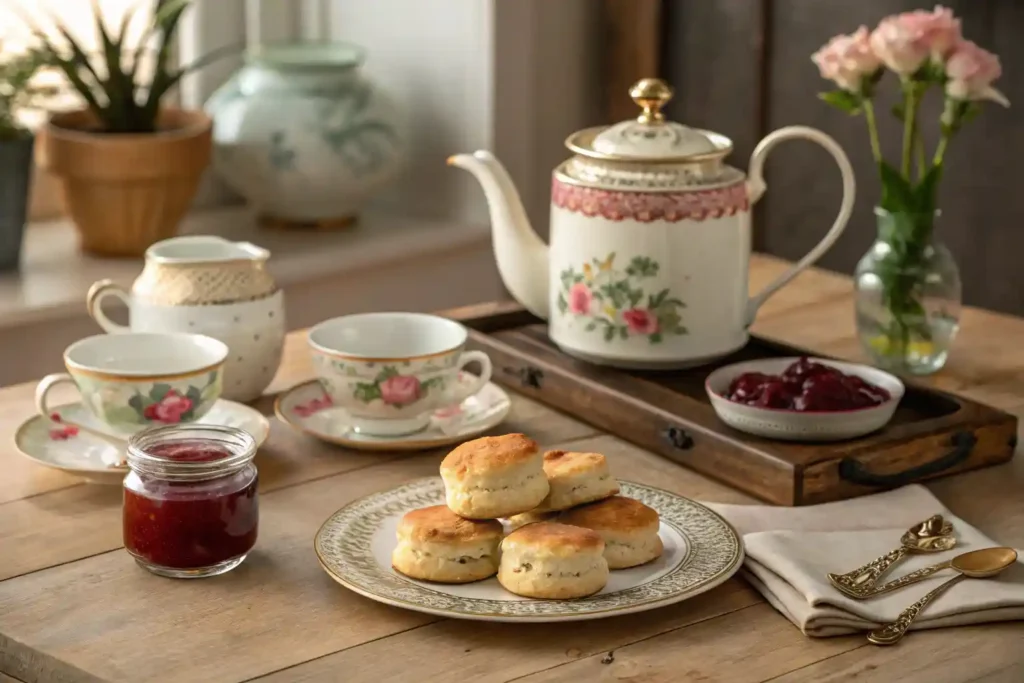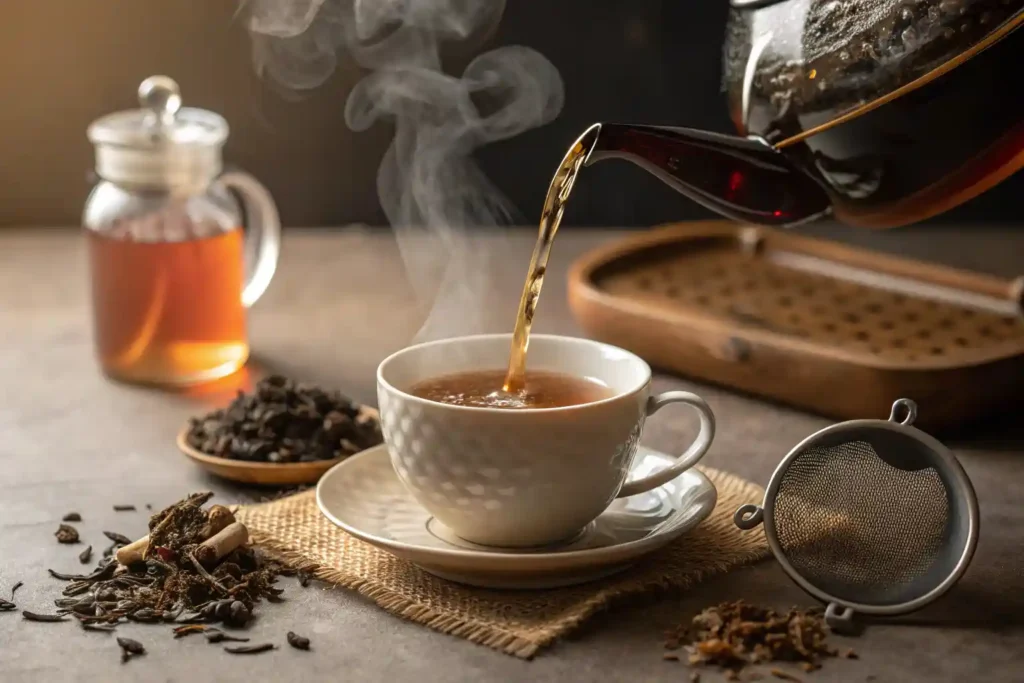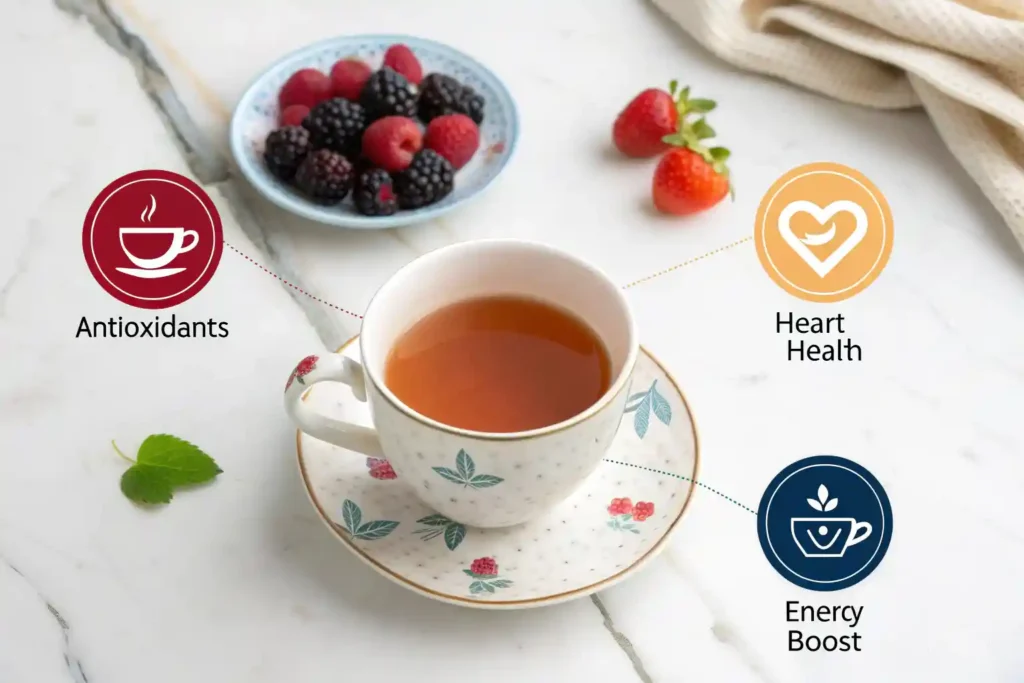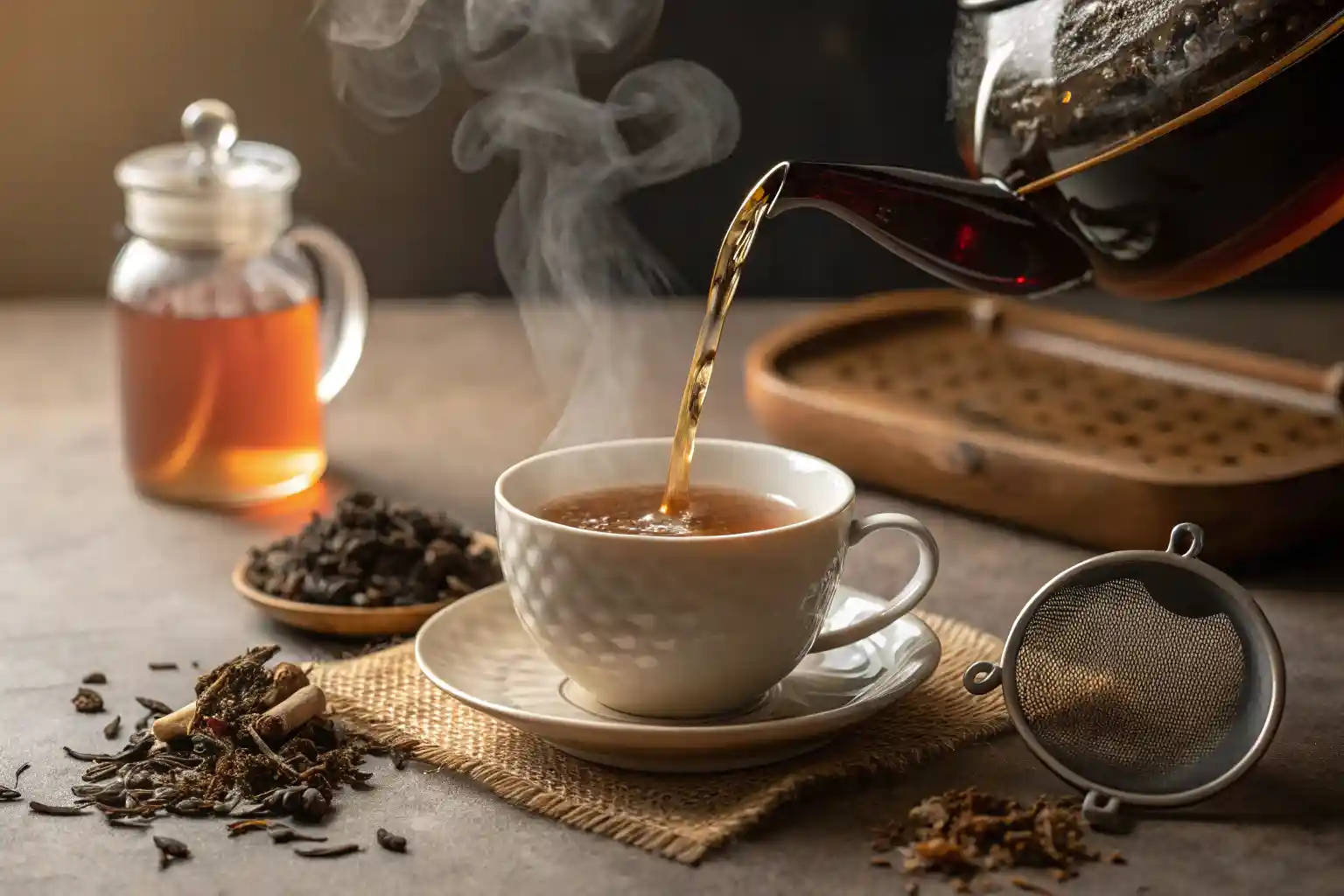Discover the rich tradition of British breakfast tea, a beloved morning ritual that combines robust flavors and cultural significance. This guide explores its ingredients, health benefits, and brewing techniques to enhance your tea experience.
Table of contents
1. What is British Breakfast Tea Made Of?
British breakfast tea is a blend of several black teas, primarily known for its strong flavor and invigorating qualities. Understanding its composition can enhance your appreciation for this classic beverage.

1.1 Common Tea Blends
- Assam Tea: Grown in India, Assam tea is known for its bold, malty flavor, making it a staple in breakfast blends.
- Ceylon Tea: Originating from Sri Lanka, Ceylon tea adds a bright, citrusy note to the blend, balancing the robustness of Assam.
- Kenyan Tea: Often included for its strong flavor and bright color, Kenyan tea contributes to the overall strength of the blend.
1.2 Flavor Profile and Characteristics
- Robustness: British breakfast tea is characterized by its strong, full-bodied flavor, making it an ideal morning beverage.
- Aroma: The blend typically has a rich, malty aroma that can be enhanced with milk or sugar.
- Color: When brewed, it produces a deep amber color, indicating its strength and richness.
1.3 Loose Leaf vs. Tea Bags
- Loose Leaf Tea: Often preferred by tea enthusiasts for its superior flavor and quality, loose leaf tea allows for better infusion and aroma.
- Tea Bags: Convenient and quick, tea bags are widely used but may contain lower-quality tea leaves. Look for brands that use whole leaves for a better experience.
2. What is British Morning Tea?

British morning tea is a cherished tradition that reflects the cultural significance of tea in daily life. It typically occurs in the morning and is often accompanied by light snacks.
2.1 Definition and Significance
- Cultural Ritual: Morning tea is more than just a beverage; it’s a moment of pause and enjoyment in the busy morning routine.
- Social Aspect: Often enjoyed with family or friends, it fosters social connections and conversations.
2.2 Comparison with Other Tea Times
- Afternoon Tea: Traditionally served with a variety of snacks and pastries, afternoon tea is a more elaborate affair compared to the simplicity of morning tea.
- High Tea: Often associated with the working class, high tea includes heartier foods and is typically served later in the day.
2.3 Typical Foods Served with Morning Tea
- Biscuits: Simple, sweet biscuits are a common accompaniment, providing a delightful contrast to the tea’s robustness.
- Scones: Often served with clotted cream and jam, scones add a touch of indulgence to the morning ritual.
- Toast: A classic choice, buttered toast pairs well with the strong flavors of breakfast tea.
3. What’s the Difference Between English Breakfast Tea and Normal Tea?
Understanding the distinctions between English breakfast tea and other types of tea can enhance your tea-drinking experience.
3.1 Definition of “Normal Tea”
- Black Tea: Often referred to as “normal tea,” black tea encompasses a wide range of varieties, including Darjeeling and Assam.
- Green Tea: Different from black tea, green tea is less oxidized and has a lighter flavor profile.
3.2 Key Differences in Flavor and Strength
- Flavor: English breakfast tea is specifically blended for a strong, robust flavor, while normal black teas can vary widely in taste.
- Strength: Typically stronger than most black teas, English breakfast tea is designed to be enjoyed with milk and sugar.
3.3 Popularity and Usage in British Households
- Daily Ritual: English breakfast tea is a staple in many British households, often consumed daily as part of the morning routine.
- Versatility: It can be enjoyed plain or with milk and sugar, making it adaptable to personal preferences.
4. Is English Breakfast Tea the Same as Earl Grey?
While both English breakfast tea and Earl Grey are popular choices, they are distinct in flavor and composition. Understanding these differences can help you choose the right tea for your mood and occasion.
4.1 Overview of English Breakfast Tea
- Blend Composition: English breakfast tea is a robust blend of black teas, primarily Assam, Ceylon, and Kenyan teas. This combination creates a strong, full-bodied flavor that is perfect for morning consumption.
- Flavor Profile: The tea is known for its malty, rich flavor that pairs well with milk and sugar, making it a comforting choice to start the day.
- Caffeine Content: English breakfast tea typically contains a moderate amount of caffeine, providing a gentle energy boost without the jitters associated with coffee.
4.2 Overview of Earl Grey Tea
- Flavoring: Earl Grey is a black tea flavored with oil of bergamot, a citrus fruit, giving it a unique floral and citrusy aroma. This distinct flavor sets it apart from traditional black teas.
- Serving Suggestions: Earl Grey is typically enjoyed without milk, allowing the delicate flavors of bergamot to shine. Some people prefer it with a slice of lemon or a touch of honey for added sweetness.
- Cultural Significance: Earl Grey has a long-standing reputation as a sophisticated tea, often associated with afternoon tea settings and elegant gatherings.
4.3 Comparison of Taste and Usage
- Taste Differences: English breakfast tea is bold and malty, while Earl Grey is lighter and more aromatic due to the bergamot. This makes them suitable for different occasions and preferences.
- Usage Context: English breakfast tea is often consumed in the morning, while Earl Grey is popular throughout the day and can be enjoyed as an afternoon tea. The choice between the two often depends on personal taste and the time of day.
5. Is British Tea Healthy?

The health benefits of British tea, particularly black tea, are well-documented, making it a popular choice for many. Understanding these benefits can enhance your appreciation for this traditional beverage.
5.1 Health Benefits of Black Tea
- Antioxidants: Black tea is rich in antioxidants, which can help combat oxidative stress and reduce the risk of chronic diseases. These compounds, such as flavonoids, play a crucial role in maintaining overall health.
- Heart Health: Regular consumption of black tea has been linked to improved heart health, including lower cholesterol levels and reduced blood pressure. Studies suggest that the flavonoids in black tea may help improve blood vessel function and reduce the risk of heart disease.
- Digestive Health: Some research indicates that black tea may support digestive health by promoting the growth of beneficial gut bacteria. This can lead to improved digestion and overall gut health.
5.2 Caffeine Content Comparison
- Caffeine Levels: English breakfast tea contains moderate caffeine levels, providing a gentle energy boost without the jitters associated with coffee. A typical cup of English breakfast tea contains about 40-70 mg of caffeine, depending on the brewing time and tea type.
- Comparison with Other Beverages: While it has less caffeine than coffee, it is stronger than most green teas, making it a suitable choice for those seeking a morning pick-me-up. Understanding your caffeine tolerance can help you enjoy tea without adverse effects.
5.3 Potential Downsides
- Acidity: Some individuals may experience acidity or digestive discomfort from consuming black tea, especially on an empty stomach. If you are sensitive to acidity, consider pairing your tea with food to mitigate this effect.
- Caffeine Sensitivity: Those sensitive to caffeine should monitor their intake, as excessive consumption can lead to insomnia or anxiety. It’s essential to find a balance that works for you, especially if you enjoy multiple cups throughout the day.
6. How to Make English Breakfast Tea
Brewing the perfect cup of English breakfast tea is an art that can be mastered with a few simple steps. Here’s how to create a delightful tea experience at home.
6.1 Recipe Ingredients
- Types of Tea: Choose high-quality loose leaf English breakfast tea or premium tea bags for the best flavor. Look for brands that use whole leaves for a richer taste.
- Water Quality: Use filtered water for the best taste, as tap water can affect the flavor of the tea. The quality of water is crucial in achieving the perfect brew.
- Optional Additions: Consider adding milk, sugar, or lemon to enhance the flavor according to your preference. Experimenting with different additions can help you discover your ideal cup.
6.2 Directions
- Boil Water: Bring fresh, filtered water to a rolling boil (around 200°F or 93°C). The right temperature is essential for extracting the full flavor from the tea leaves.
- Measure Tea: Use one teaspoon of loose leaf tea per cup or one tea bag per cup. Adjust the amount based on your strength preference.
- Steep: Pour the boiling water over the tea and let it steep for 3-5 minutes, depending on your strength preference. Longer steeping results in a stronger flavor, while shorter steeping yields a milder taste.
- Strain and Serve: If using loose leaf tea, strain the tea into a cup. Add milk and sugar if desired, and enjoy! The addition of milk can create a creamy texture that complements the tea’s robustness.
6.3 Tips for Achieving the Perfect Brew
- Experiment with Steeping Time: Adjust the steeping time to find your preferred strength; longer steeping results in a stronger flavor. Keep in mind that over-steeping can lead to bitterness.
- Temperature Matters: Ensure the water is at the right temperature to avoid bitterness; boiling water is ideal for black tea. If the water is too cool, it may not extract the full flavor.
- Use Quality Ingredients: The quality of tea and water significantly impacts the final taste, so choose wisely. Investing in high-quality tea can elevate your tea-drinking experience.
7. Conclusion
In conclusion, British breakfast tea is a delightful beverage that not only offers a rich cultural experience but also pairs wonderfully with various breakfast options. Whether you enjoy it with hearty meats, a quick breakfast pizza, or fresh apple recipes, the versatility of this tea enhances your morning routine. Embrace the tradition of tea drinking and explore the many ways to enjoy this classic beverage.
For more ideas on how to complement your tea, check out these articles:
Best Breakfast Meats: Hearty Meal
Quick Delicious Breakfast Pizza
Key Takeaways:
- Cultural Significance: British breakfast tea is an integral part of British culture, often enjoyed in the morning as a comforting ritual.
- Health Benefits: Rich in antioxidants and linked to heart health, this tea offers numerous health benefits when consumed in moderation.
- Brewing Techniques: Mastering the art of brewing can elevate your tea experience, allowing you to enjoy the full flavor and aroma of this classic beverage.
8. FAQs
8.1 What is British breakfast tea made of?
British breakfast tea is typically a blend of several black teas, primarily Assam, Ceylon, and Kenyan teas. This combination creates a robust and full-bodied flavor that is perfect for morning consumption.
8.2 What is British morning tea?
British morning tea refers to the practice of enjoying tea in the morning, often accompanied by light snacks such as biscuits or toast. It is a cherished ritual that fosters social connections and provides a moment of relaxation before the day begins.
8.3 What’s the difference between English Breakfast tea and normal tea?
English breakfast tea is a specific blend of black teas designed for a strong flavor, while “normal tea” can refer to a variety of teas, including black, green, and herbal teas. English breakfast tea is generally stronger and more robust than many other types of tea.
8.4 Is English Breakfast tea the same as Earl Grey?
No, English breakfast tea and Earl Grey are not the same. English breakfast tea is a blend of black teas known for its strength, while Earl Grey is a black tea flavored with bergamot oil, giving it a distinct citrusy aroma and flavor.
8.5 Is British tea healthy?
Yes, British tea, particularly black tea, offers several health benefits, including antioxidants that can help reduce the risk of chronic diseases. It also supports heart health and provides a moderate caffeine boost, making it a healthy choice when consumed in moderation.
8.6 How to make English Breakfast tea?
To make English breakfast tea, boil fresh filtered water, measure one teaspoon of loose leaf tea or one tea bag per cup, steep for 3-5 minutes, and serve. You can add milk, sugar, or lemon according to your taste preferences.
8.7 Can I drink English Breakfast tea in the evening?
While English breakfast tea contains caffeine, it can be enjoyed in the evening if you are not sensitive to caffeine. However, if you prefer a caffeine-free option, consider herbal teas or decaffeinated versions.
8.8 What are some popular brands of English Breakfast tea?
Some popular brands include Twinings, PG Tips, Yorkshire Tea, and Harney & Sons. Each brand offers its unique blend and flavor profile, so exploring different options can enhance your tea experience.
8.9 How should I store my tea?
To maintain freshness, store your tea in an airtight container away from light, heat, and moisture. This will help preserve the flavor and aroma of your tea for a longer period.

